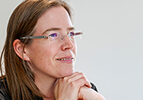 COMPARATIVE LITERATURE
COMPARATIVE LITERATUREEuropean travelogues in context
Dr. Sandra Vlasta joined the Gutenberg Institute for World Literature and Written Media of Johannes Gutenberg University Mainz in October 2017 with a Marie Skłodowska-Curie Fellowship. Here, the Viennese expert in comparative literature is currently working on her research project on European Travelogues in Context. The Socio-Political Dimension of Travelogues in Europe: 1760 – 1850.
 ENGLISH & LINGUISTICS
ENGLISH & LINGUISTICSTeaching English in Sri Lanka
Students of Johannes Gutenberg University Mainz (JGU) have the opportunity to teach for a period of six months in Sri Lanka. This unusual project was initiated about two years ago. Anke Lensch of the Department of English and Linguistics launched the project, supervised by Professor Britta Mondorf and in cooperation with Deutsche Gesellschaft für Internationale Zusammenarbeit (GIZ).
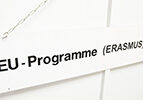 JGU INTERNATIONAL
JGU INTERNATIONALErasmus scholarships for teaching staff and personnel
The Erasmus training program was introduced in 1987 by the European Union. Since then, it has promoted the internationalization of the educational landscape on many levels. Erasmus is primarily directed at students. But also teaching staff and other university personnel can benefit from the program. This aspect plays a major role at Johannes Gutenberg University Mainz.
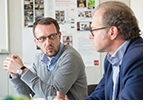 JIHADISM ON THE INTERNET
JIHADISM ON THE INTERNETTracking down Islamist propaganda
The Jihadism on the Internet interdisciplinary junior research group started last year. The researchers analyze online radical Islamist propaganda and track down all individuals that respond in any way to this kind of material. The group is also preparing a unique online platform. The project at the Department of Anthropology and African Studies at Johannes Gutenberg University Mainz receives funding from the German Federal Ministry of Education and Research (BMBF) to the tune of EUR 2.7 million.
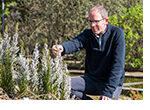 EVOLUTIONARY SBIOLOGY
EVOLUTIONARY SBIOLOGYOn the trail of biodiversity
In order to research the mechanisms involved in speciation, Dr. Michael Pirie has selected a plant genus which actually originated in Europe but which has developed into an unbelievable number of varieties mainly in South Africa. The botanist, who works at the Institute of Organismic and Molecular Evolution (IOME) at Johannes Gutenberg University Mainz (JGU), has been following the trail of the Ericaceae (heather) family for a decade now.
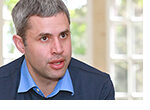 BIOPHYSICS
BIOPHYSICSThe mystery of flexible proteins
Professor Edward Lemke conducts research into intrinsically disordered proteins. Among other things, he has developed new methods of observing these albumins. He has been a professor at the Faculty of Biology of Johannes Gutenberg University Mainz (JGU) since January 1, 2018. Here he works in collaboration with the Faculty of Chemistry, Pharmaceutical Sciences, and Geosciences. He is also Adjunct Director of the Institute of Molecular Biology (IMB) and a Fellow of the Gutenberg Research College (GRC).
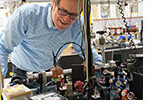 PRISMA CLUSTER OF EXCELLENCE
PRISMA CLUSTER OF EXCELLENCEThe proton radius puzzle
His results have made headlines beyond the academic world of physics. In May 2016, Randolf Pohl was appointed to a professorship at the PRISMA Cluster of Excellence of Johannes Gutenberg University Mainz (JGU). Using a new technique, he succeeded in measuring the size of the proton, one of the fundamental building blocks of the atomic nucleus. According to his results, the radius of the proton is four percent smaller than the previous value accepted by science. This result is puzzling and could have serious consequences for the Standard Model of particle physics.
 PRISMA CLUSTER OF EXCELLENCE
PRISMA CLUSTER OF EXCELLENCEMaking the invisible visible
It is the first exhibition in the School of Seeing on the Gutenberg campus that is concerned with the natural sciences. Through its ZoomIn—Making the Invisible Visible show, the Precision Physics, Fundamental Interactions and Structure of Matter Cluster of Excellence, or PRISMA for short, is providing insight into its many and varied branches of research. Multimedia exhibits show how modern technology is used to gain an in-depth view of the world’s tool box.
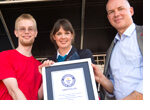 GUINNESS WORLD RECORDS
GUINNESS WORLD RECORDSA Guinness World Record for Mainz physicists
By constructing the longest magnetic ball accelerator in the world, Johannes Gutenberg University Mainz (JGU) set a new official Guinness World RecordTM. A team of physicists, supported by high schoolers from two schools in Mainz, worked for months on the project. The Mainz Public Transport Authority even cleared one of its tram lines for the world record experiment. When the final ball crossed the finishing line, the Mainz physicists started celebrating with hundreds of visitors of all ages.
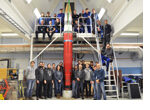 RESEARCH ROCKET
RESEARCH ROCKETPioneering measurements in space
The MAIUS-1 sounding rocket mission has enabled physicists to generate a Bose-Einstein condensate in space for the first time. This will allow them to measure the Earth's gravitational field more precisely in the future and, crucially, to test Einstein's equivalence principle more accurately than ever before. The research group Experimental Quantum Optics and Quantum Information at Johannes Gutenberg University Mainz (JGU) is closely involved in the project.
